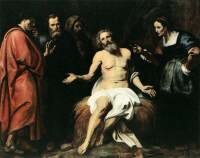 Job (Hebrew אִיּוֹב, Iyowb, "hated"), is a character in the Book of Job in the Hebrew Bible. In brief, the book begins with an introduction to Job's character — he is described as a rich, blessed man who fears God and lives righteously. Satan, however, challenges Job's integrity, and so God gives Job into Satan's hand, ending in tragedy for Job: the loss of his children, wealth, and physical soundness. The main portion of the text consists of the discourse of Job and his three friends concerning why Job was so punished, ending in God answering Job. Job is also a prophet in Islam.
Job (Hebrew אִיּוֹב, Iyowb, "hated"), is a character in the Book of Job in the Hebrew Bible. In brief, the book begins with an introduction to Job's character — he is described as a rich, blessed man who fears God and lives righteously. Satan, however, challenges Job's integrity, and so God gives Job into Satan's hand, ending in tragedy for Job: the loss of his children, wealth, and physical soundness. The main portion of the text consists of the discourse of Job and his three friends concerning why Job was so punished, ending in God answering Job. Job is also a prophet in Islam.Job had Seven sons and three daughters and
His sons took turns entertaining each other with feasts; each time they completed a cycle of feast days, Job sent to them and purified them, offering burn-offerings for each one in case any of them had cursed God in their hearts. He was "blameless and upright; he feared God and shunned evil. His good character is discussed in depth later in the book. (Job 1:1;4,5).
He possessed 7,000 sheep, 3,000 camels, 500 yoke of oxen, and 500 female donkeys, and very many servants, so that this man was the greatest of all the people of the east. (Job 1:3)
Satan asserts that Job does not really love God, but fears God for blessing. To show that this is not so, God tested Job by giving Satan power over his property and family. In rapid succession, Job is suddenly informed by four servants of four different tragedies to strike his household.
In one assembly of the angels before God, Satan also comes, having patrolled the earth.




























